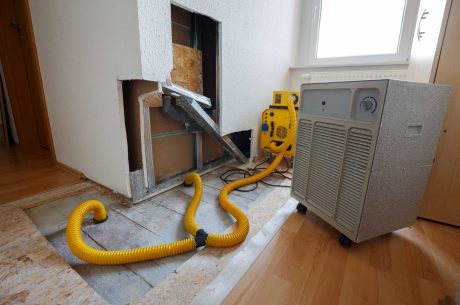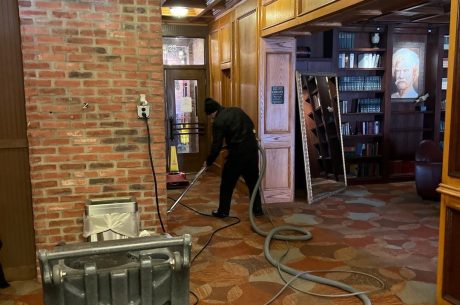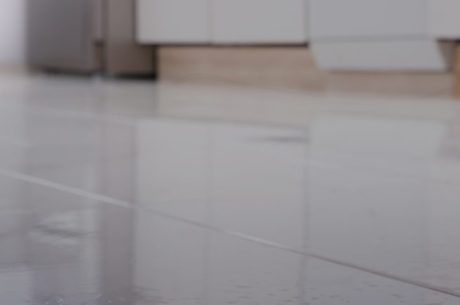What are the different types of water damage and why do they matter so much for your home or business? In this guide, we’ll walk you through the 3 major types of water damage—Category 1, 2, and 3—how they differ, the risks they bring, and what you should do if you’re facing one. Whether it’s a clean water leak from a burst pipe or a dangerous sewage backup, understanding these types of water damage can make all the difference in protecting your property and your health.
Table of Contents
Why Understanding the TYPES OF WATER DAMAGE Is Crucial
Most homeowners hear “water damage” and think it’s all the same—but it’s not. The types of water damage determine how dangerous the water is, how it should be handled, and how long you have to act before things get worse.
Without the proper response, even clean water can turn into a serious hazard. Mold growth, structural weakening, and contamination all hinge on what type of water damage you’re facing. That’s why recognizing the category early—and responding fast—could save your home and protect your family’s health.
Category 1: Clean Water – But Don’t Let the Name Fool You
This is the least dangerous of the three types of water damage—but it still needs attention.
Category 1 water damage originates from clean sources like:
- Broken water supply lines
- Overflowing sinks or bathtubs (without contaminants)
- Appliance malfunctions (like a leaky refrigerator or washing machine)
This water is technically safe to touch and doesn’t contain harmful bacteria—at first. But here’s the catch: if it’s left untreated for too long, clean water can quickly escalate into Category 2 or even Category 3. Within 24 to 48 hours, mold can start growing, and bacteria may begin to develop if the water comes in contact with other materials.
So even though this is the most “benign” of the types of water damage, acting fast is still essential.

Category 2: Gray Water – More Than Just Dirty Water
Category 2 water damage, or “gray water,” comes from sources that contain contaminants and can cause discomfort or illness if ingested or touched.
Common sources include:
- Dishwasher or washing machine overflows
- Toilet overflow (with urine but no feces)
- Sump pump failures
Gray water often contains chemicals, bacteria, or other microorganisms. Exposure can lead to health issues like skin irritation or gastrointestinal distress. And like Category 1, Category 2 water can rapidly degrade into Category 3 water if left unaddressed.
The takeaway? If your damage falls into this category, professional help is no longer optional—it’s necessary.
Category 3: Black Water – The Most Dangerous of All TYPES OF WATER DAMAGE
This is the most severe and hazardous of all types of water damage. Category 3 water is also known as “black water,” and it contains harmful bacteria, sewage, and other toxic substances.
Sources include:
- Sewage backups
- Floodwaters from rivers or streams
- Water from toilets containing feces
- Long-standing water from broken pipes or roof leaks
Black water exposure poses serious health risks. We’re talking viruses, bacteria, and dangerous pathogens. It can contaminate anything it touches—carpet, drywall, furniture—and all of it must be thoroughly cleaned or disposed of.
This isn’t a DIY situation. Category 3 water damage should always be handled by trained professionals equipped with the right gear and decontamination tools.
Why You Should Never Ignore the TYPES OF WATER DAMAGE
No matter which category you’re dealing with, procrastinating only makes things worse. Here’s what can happen if water damage is ignored:
- Structural damage: Moisture weakens walls, floors, and supports over time.
- Mold growth: Mold thrives in moist conditions and can begin growing in as little as 24 hours.
- Air quality issues: Contaminated water can impact indoor air and trigger allergies or respiratory problems.
- Decreased property value: Homes with a history of water damage—especially if not properly repaired—can lose value.
And let’s not forget the most expensive consequence of all: the insurance nightmare that can occur when damage isn’t properly documented or treated.
What to Do Immediately After Discovering Water Damage
- Identify the source – Try to stop the water at its origin if it’s safe to do so.
- Turn off electricity – Especially important if water is near outlets or appliances.
- Avoid contact with contaminated water – Especially Category 2 and 3.
- Document the damage – Photos and notes help with insurance claims.
- Call a professional – Fast.
Even if you’re dealing with clean water, remember that all types of water damage can evolve quickly.
The Role of Professionals in Handling TYPES OF WATER DAMAGE
When it comes to professional restoration, experience and equipment matter. At PuroClean of Bloomington, we don’t just remove water—we identify the type, assess the risks, and restore your home to safety.
Our certified team uses industrial-grade drying equipment, moisture detection tools, and EPA-approved cleaners to ensure your space is not only dry but also free of mold, bacteria, and long-term hazards.
We’re not just cleaning up—we’re protecting your future.
FAQs About the TYPES OF WATER DAMAGE
Q: Can Category 1 water become Category 2 or 3?
A: Yes. If clean water is left standing or comes into contact with building materials, it can become contaminated and escalate to Category 2 or 3 within 24–72 hours.
Q: Is it safe to clean up water damage myself?
A: For Category 1, maybe—but only if you’re sure of the source and act fast. For Category 2 and especially Category 3, professional cleanup is essential for your safety.
Q: Will insurance cover all types of water damage?
A: Not always. Coverage depends on the source of the damage and your policy. Sudden accidents (like burst pipes) are usually covered. Flooding or long-term leaks might not be unless you have specific coverage.
Q: How fast should I act after discovering water damage?
A: Immediately. Mold can begin forming in 24–48 hours. The sooner you act, the more you can prevent health risks and reduce costs.
Q: What are signs that water damage is getting worse?
A: Musty smells, warping walls or floors, mold spots, and worsening discoloration are all signs that untreated water damage is spreading.
Don’t Wait Until It’s Too Late—Call PuroClean of Bloomington Today
Whether you’re dealing with a minor leak or a full-blown sewage backup, understanding the types of water damage is your first step to protecting your home. But knowing what to do next—and who to call—makes all the difference.
At PuroClean of Bloomington, we specialize in restoring homes and peace of mind. Our experienced technicians respond quickly, identify the category of water damage, and get to work right away to prevent mold, structural issues, and long-term headaches.
Don’t risk your health or your home. Call PuroClean of Bloomington at (309) 433-0900 or visit us for free inspection!
We’re here 24/7, ready to help you recover—because when it comes to the types of water damage, timing is everything.



 PuroClean Of Bloomington
PuroClean Of Bloomington